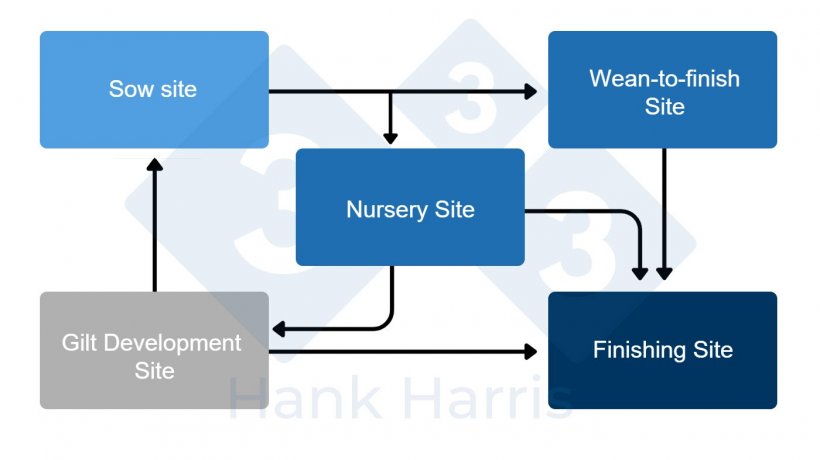In 1999, Hank and Isabel Harris wrote two articles about multi-site pig production for 333. In celebration of 333's 25th anniversary, we asked Hank Harris for an update on these articles.
Isolated weaning and isolated finishing in separate geographic locations was the basis for creation of multi-site pig production (Harris 1988, 2000). Initial studies carried out in 1987 showed that weaning pigs into an isolated nursery at 10 days of age from a high health status farm resulted in improved performance compared to the littermate pigs remaining on the Farrow to Finish source farm. This was subsequently confirmed by different authors.

The first multi-site farm was established in 1988 by Chuck Sand near Columbus, NE, USA, for the multiplication of breeding stock. The 3 sites (Breeding/Gestation, Nursery, and Finisher) were located with at least two miles separation between sites and from other pig farms (Harris 2000). The elimination of infectious agents by isolated weaning and the maintenance of high health status of pigs through nursery and finishing were advantages deemed necessary for successful breeding stock production. Over the next ten years, there was a phenomenal acceptance and unexpected implementation of multi-site systems within North America and Worldwide (Chile, Mexico 1990), (Canada, 1992), (Argentina 1993), (Brazil, Germany, 1994), (Denmark, Poland, Spain, Italy 1996), (England, China, France 1997) and (Scotland, 1998).
Are the original principles of multi–site production being respected?
Unfortunately, many multi-site systems have now been constructed without proper separation between sites and away from other pig farms (Figure 1 from Passafaro et al, 2020). As documented by several authors both aerosol transmission and transport of pigs between sites contributes to difficulties in prevention and control of infectious diseases in multi-site systems.
As systems increased in size, other management changes were made especially in pig flow. Originally, the intent was for nurseries to be stocked on an all-in; all-out basis from one or 2 sow sites for production of breeding animals. Again, compromises have been made in many systems resulting in multiple sources of both weaned pigs and nursery pigs to finishers on a continuous flow basis.
Due to the loss of strict adherence to geographic isolation combined with poor pig flow concepts, the infectious elimination and disease control benefits originally envisioned for multi-site production are often lost.
Even though the implementation of multi-site systems has not been as originally conceived, US pork production per sow continues to increase at a rate of approximately 1.9% per year (Tokach 2016).

The role of Multi- Site pig production on elimination of infectious agents
Porcine Reproductive and Respiratory Syndrome virus (PRRSV) evolved in the 1980s. Techniques were developed using multi-site pig production to create PRRSV-negative pigs for stocking herds free of the virus (Donadeu et al 1999; Gramer et al 1998). Plomgaard (1998) eliminated three infectious agents without depopulation (Mycoplasma hyopneumoniae, Actinobacillus pleuropneumonia, and PRRSV) from a breeding/gestation site of a multi-site farm in Denmark. Modern-day multi-site systems continue eliminating infectious agents from sows without depopulation or by isolated weaning. For example, Poulin and Christianson (2013) eliminated Foot and Mouth Disease virus by isolated rearing in China.
Some initial benefits of Multi-site Production have evolved and several groups have confirmed and refined the enhanced performance of isolated weaning. Reduced immune activation created by isolated rearing profoundly affects carcass composition, growth rate, feed efficiency, and lysine requirements (Williams, et al (1997). Crowe et al (1996) suggested that high environmental levels of endotoxin in the farrow to finish farms could account for poor performance of weaned pigs.
The trade-off between the age of weaning for infectious agent elimination versus performance, immune response, and behavior was studied extensively over the past 25 years. It was determined that 21-day weaning was preferable over earlier weaning age for both performance in the nursery and finisher stage (Main et al (2004). No difference in physiologic and behavioral responses was found between 14-day and 21-day weaning (Davis et al 2006). Tsai et al (2018) found that isolated rearing increased intestinal microbial diversity and enhanced growth performance. Whiting and Pasma (2008) studied the animal welfare aspects of multi-site production and found that the advantages of isolated rearing outweigh any welfare concern, especially if weaning occurs at 21 days or older.
Replacement management in Multi-Site production systems
The widespread adoption of multi-site production systems created a need for “effective gilt management for replacement targets for improved lifetime performance” (Williams et al 2005).
Gilt replacements from a nursery (usually 7-8 weeks of age) are placed in a gilt development unit (GDU), a separate building apart from sow, nursery, wean-to-finish or finisher sites (see Figure). In the GDU, replacements are exposed to the microbiome of the sow site to allow for acclimatization. Prior to the development of the GDU concept, sow replacement rates in large systems in the U.S. were as high as 60-70% annually. It is interesting to note that in traditional farrow to finish one site farms that produce their own replacements acclimatization occurred more naturally. Connor (2023) has suggested that the introduction of PRRSV-resistant pigs (Burkard, 2018) may result in re-establishing farrow to finish farms on one site due to labor shortages. A GDU would still be advised for a farrow to finish farm if gilt replacements are outsourced.
Air filtration to prevent infectious agent introduction
Spronk (2010) reported that filtration systems installed in large sow sites (greater than 300 sows) would prevent the introduction of PRRSV. Air filtration has been used since 1995 to prevent infectious agent introduction into a farrow to finish farm (Cariolet et al., 2000). Desrosiers and Cousin (2023) reviewed the various methods and applications of air filtration, especially concerning boar studs and sow sites. Thus far, installing filters in nursery, wean-to-finish and finisher sites appears impractical financially.
Acknowledgment: The comments and edits by Drs Isabel Harris and Bob Glock are greatly appreciated.




